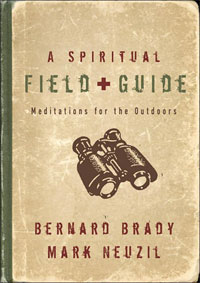Book Notes
 Bernard Brady and Mark Neuzil, A Spiritual Field Guide; Meditations for the Outdoors (Grand Rapids: Brazos, 2005), 192pp.
Bernard Brady and Mark Neuzil, A Spiritual Field Guide; Meditations for the Outdoors (Grand Rapids: Brazos, 2005), 192pp.
I don't think they use the word, but what Brady and Neuzil offer in their little book is an anthology of readings about creation and nature. Perhaps they use the word "meditation" instead because all the readings are short, almost never longer than one page and sometimes much less. In the introduction, then, they suggest that one read these many short texts in a deliberate, reflective fashion, rather than plow straight through them from beginning to end. In the introduction they offer seven different reading plans for week-long, weekend, or single-day trips.
Many of the readings come directly from Scripture, many others from a broad array of Christian writers as diverse as Wendell Berry and Annie Dillard to Martin Luther and Mother Teresa, while still others include non-Christian traditions like Thoreau, John Muir, Chief Black Elk, and Chuang Tzu. They organize the readings into five thematic chapters—on creation and the creator, the human place in creation, the notion of a "special spot" ("thin" places or times when God speaks to us in special ways), journey in the wilderness, and the broad purview of all God's creatures. The authors give little to no attention to the problem(s) of evil in creation (natural evil, which in some ways is more troublesome than moral evil that one can attribute to human free will), what Tennyson described as "nature red in tooth and claw," or to the bleaker implications of a materialist view of nature found in a Dawkins or a Dennett. But perhaps that is the way it should be for believers who confess that "God created the heavens and the earth" and then seven times declared His creation good. The readings direct us to important themes of human dependence, interdependence, gratitude, responsibility, hope, and purpose, all appropriate to those who confess with Paul that God is "clearly seen" in His creation when viewed through the eyes of faith.


